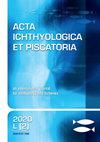Genetic diversity of the yellowfin seabream, Acanthopagrus latus (Actinopterygii: Perciformes: Sparidae)—An enhancement species in Dongshan Bay
IF 1
4区 农林科学
Q3 FISHERIES
引用次数: 1
Abstract
Dongshan Bay is located on the west side of the Taiwan Strait, which had abundant fishery resources in the past. With the increase in fishing pressure, resources have declined. To restore the fishery resources in Dongshan Bay and to increase fishing yield, much enhancement and release work has been carried out in Dongshan Bay. The yellowfin seabream, Acanthopagrus latus (Houttuyn, 1782), is an important enhancement species in Dongshan Bay that is also frequently captured. Due to yearly progress in enhancement and release, it is necessary to study the current status of the genetic diversity of yellowfin seabream in Dongshan Bay. The results show that all yellowfin seabream populations have high genetic diversity, which is mainly related to its breeding habits and growth rate, and this ensures a large recruitment stock in the natural seas. The current population has differentiated from the historical population due to a change in genetic structure, and many historical haplotypes have been lost. The results of this study provide a reference for fishery management departments to formulate management measures and conservation policies specifically for yellowfin seabream. In particular, yellowfin seabream is a hermaphroditic and protandrous species. Targeting an older age group as the main fishing subject is not conducive to its breeding protection and resource growth, and therefore, fishing of an older age group should be restricted in fishery production.东山湾黄鳍鲷(Acanthopagrus latus)的遗传多样性——一个增强种
东山湾位于台湾海峡西侧,过去渔业资源丰富。随着捕捞压力的增加,资源减少了。为恢复东山湾渔业资源,提高渔业产量,在东山湾进行了大量的整治放生工作。黄鳍鲷Acanthopagrus latus (Houttuyn, 1782)是东山湾重要的增殖种,也是经常被捕获的物种。由于东山湾黄鳍海鲷的增养和放养逐年推进,有必要对其遗传多样性现状进行研究。结果表明,所有黄鳍海鲷种群具有较高的遗传多样性,这主要与其繁殖习性和生长速度有关,这保证了在自然海域有大量的补充种群。由于遗传结构的改变,当前种群与历史种群发生了分化,许多历史单倍型丢失。研究结果可为渔业管理部门制定针对性的黄鳍鲷管理措施和养护政策提供参考。特别是黄鳍鲷是一种雌雄同体和雌雄同体的物种。以老年群体为主要捕捞对象不利于老年群体的养殖保护和资源增长,因此在渔业生产中应限制老年群体的捕捞。
本文章由计算机程序翻译,如有差异,请以英文原文为准。
求助全文
约1分钟内获得全文
求助全文
来源期刊

Acta Ichthyologica Et Piscatoria
FISHERIES-ZOOLOGY
CiteScore
2.20
自引率
0.00%
发文量
31
审稿时长
>12 weeks
期刊介绍:
ACTA ICHTHYOLOGICA ET PISCATORIA (AIeP) is an international, peer-reviewed scientific journal that publishes articles based on original experimental data or experimental methods, or new analyses of already existing data, in any aspect of ichthyology and fisheries (fin-fish only).
 求助内容:
求助内容: 应助结果提醒方式:
应助结果提醒方式:


